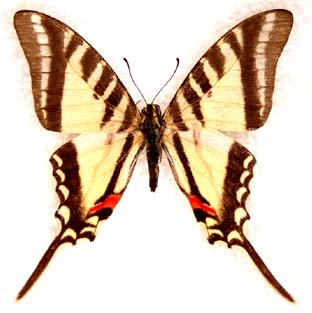Eurytides celadon (Lucas, 1852)
|
 Havana, Cuba; 5/38 Havana, Cuba; 5/38 |
| E. celadon is known only from the island of Cuba
though rare strays have been reported from S Florida. Apparently common
throughout the island. Very similar and closely related to E
marcellinus, E philolaus , E
anaxilaus and E zonaria. Like
the other members of this group, fresh specimens have a blue green coloration
to their wings which fades with time. |
Eurytides marcellinus (Doubleday, 1845)
|
 Roselle, Jamaica; June
10 1978 Roselle, Jamaica; June
10 1978 |
| E. marcellinus is known only from Jamaica
where it is extremely local and seasonal in appearance. Some years may
go by with no individuals being seen, while other years it undergoes a
population explosion and hundreds may be found in one day. One main colony
seems to be the species only stronghold, located in Roselle just east of
Kingston. E. marcellinus is currently threatened with extinction
due to its limited range, food plant restriction (Oxandra sp) and
intense developmental pressures in the Kingston area |
Eurytides zonaria (Butler, 1869)
|
 Peninsula de Barahona, Domincan
Republic; 6/77 Peninsula de Barahona, Domincan
Republic; 6/77 |
| E. zonaria is the Hispaniolan representative
of this group, and shares population dynamics with E.
marcellinus (above). Most records are from the southern Dominican
Republic where it frequents dryer habitats and is extremely local and seasonal
in occurrence. Rare in collections. |
Eurytides anaxilaus (C & R Felder,
1864) [ = Eurytides arcesilaus (Lucas, 1852)]
|
 Monay,
Trujillo, Venezuela; 6/70 Monay,
Trujillo, Venezuela; 6/70 |
| E. anaxilaus is a mainland representative of this
group, known from Panama, N Colombia and Venezuela. Like its cousins it
is both local and extremely seasonal, but can be abundant at the right
place and time. |